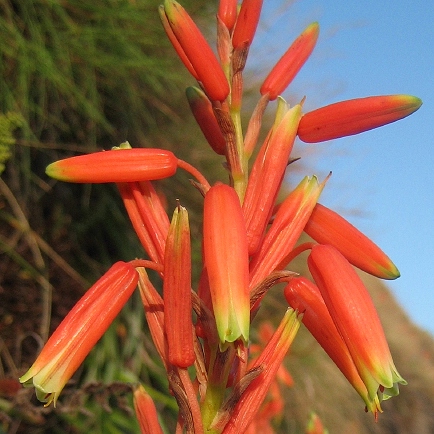| Home |
Strange Wonderful Things Rare and exotic plants |
 |
|---|
Aloe inyangensis
"Grass Aloe"
Germinating the seeds
Plant the seeds immediately for best results
Each seed may be started in individual, small containers about 3 inches (8 cm) tall. Fill each pot with a fast-draining soil such as cactus soil (which you can make with 1 part potting soil and 1 part coarse sand). Water the soil and place a seed on top. Cover with a very thin layer of soil - just enough to barely cover the seeds, because the seeds need some light to germinate. Water the top soil.
Until the seeds sprout, ensure that the soil surface always stays moist. You can maintain moisture by enclosing the pots in a plastic bag or humidity dome kept open a crack for fresh air to enter. You may need to drip a few drops of water over the seeds every day or 2.
Keep them at about 68-76 degrees F (20-24°C). I have no information about how well they sprout outside this temperature range. Keep them in a bright spot, away from direct sunlight. A fluorescent bulb kept 5 inches (12 cm) away provides the right amount of light.
The seeds may take from 1 to 4 months to sprout. This variable germination time is an adaptation that ensures the plant's survival in the wild.
Once they sprout, give them bright light, but shade them from strong sun exposure. For the first few weeks, continue keeping the soil surface moist (but not soggy). After that, start letting the soil get progressively drier over the coming months.
Most potting soils contain fertilizer, so your seedlings shouldn't need feeding the first 2-3 weeks. After that, give a light dose (1/4 strength) of all-purpose fertilizer about every 4 weeks.
Repot gently to avoid letting the soil ball break apart, which can damage the roots and injure the plant. To help keep the soil together, water it well and wait 30 minutes.
Protect the plants from freezing temperatures the first 2 years.
General cultivation tips for this plant.
| Home |
Strange Wonderful Things Rare and exotic plants |
|
|---|---|---|
| Entire site Copyright 2003-2023 by Strange Wonderful Things, except as noted | ||

